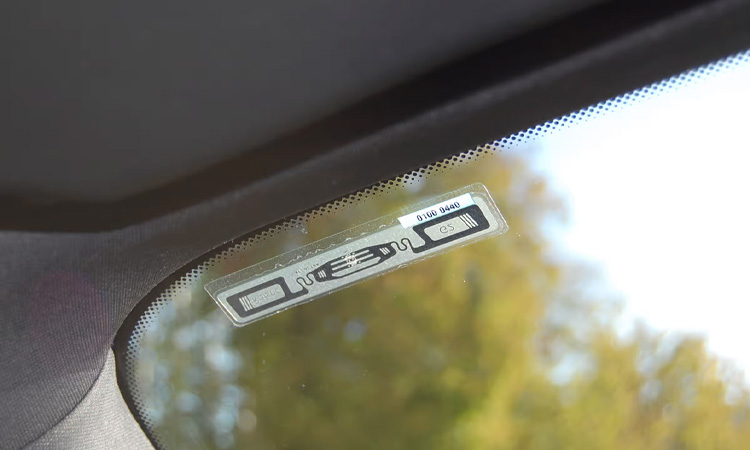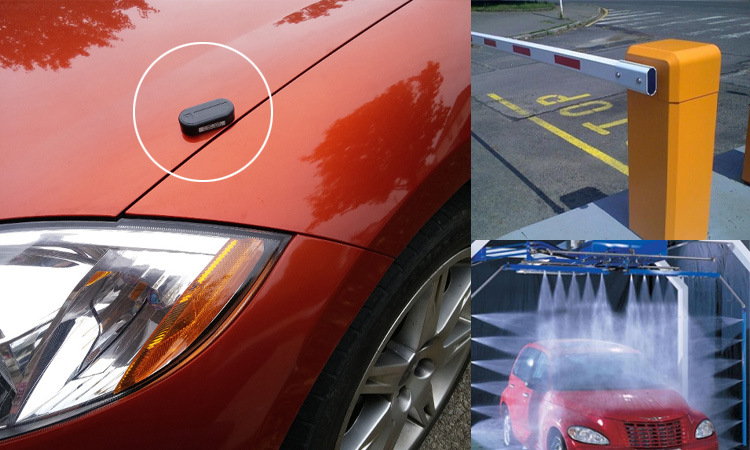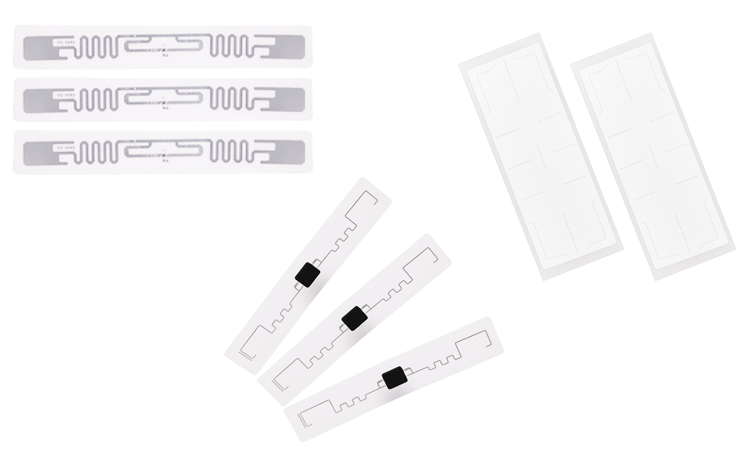If you’ve ever wondered what those small rectangular tags on your car’s windshield or license plate are for, they’re probably RFID tags. RFID stands for Radio Frequency Identification, a technology that tracks and identifies objects wirelessly. In the automotive industry, RFID tags are used for various applications, from asset management to access control. In this article, we’ll cover everything you need to know about RFID tags for cars.
What is an RFID Tag for a Car?

An RFID tag for a car is a small electronic device that contains a microchip and an antenna. The tag is attached to a car, and an RFID reader can read it. The tag responds with its unique identification number when the reader sends out a radio signal. This number can be used to track the car, manage inventory, and provide secure access to restricted areas.
There are two main types of RFID tags for cars: passive and active. Passive tags do not have their own power source, and they rely on the energy from the RFID reader to transmit their data. Active tags have their own power source and can transmit their data over a longer range.
RFID tags work by using radio frequency technology to transmit data wirelessly. The RFID tag contains a microchip and an antenna, and when it is within range of an RFID reader, the reader sends out a radio signal. The tag responds to the signal by transmitting its unique identification number to the reader. This number can track the car, manage inventory, and provide secure access to restricted areas.
Do I Need RFID Tag for Car?
The news of the December 2021 attack on motorists has pushed the development of RFID tags in cars even further. They began phasing out Touch’s and SmartTag lanes. More and more lanes are starting to adopt RFID technology. It means that all motorists will need to use RFID tags in their cars in the future. Early RFID electronic tag in cars may become the primary method of highway taxation.
An RFID tag for car can be described as a credential for entering and exiting the vehicle entrance at the door. You can attach it to your car. The RFID sensor on the gate will wirelessly read the RFID tag in car that wants to enter the area. Verify the identity through the vehicle to get access to the area.
In addition, there are many features you can use with RFID labels in your car, in addition to identity verification.
Depending on the type of RFID tag chosen, you can achieve a variety of functions. For example, car dealers usually choose more sophisticated RFID tags. These tags can provide real-time location information about the vehicle’s position. Some standard RFID tags are suitable for parking lot management or gate access. Of course, you can also use RFID tags for other different industries. Some of the more typical ones are retail, healthcare, commercial, and manufacturing.
RFID tags are small electronic devices that use radio waves to communicate with readers or scanners. In the automotive industry, RFID tags are increasingly being used to automate many processes and improve efficiency and security.


Toll Collection
One common use of RFID tags in cars is for toll collection. By attaching an RFID tag to a car, drivers can pass through toll booths without stopping to pay. Instead, the toll is automatically deducted from a prepaid account linked to the RFID tag.
Vehicle Identification
In-vehicle RFID provides an effective way for car dealerships and other companies to identify vehicles. Through an application, these companies can read the unique RFID tag in cars to extract a record of the car purchase. It eliminates the need for them to worry about identifying vehicle usage with the same characteristics in a parking lot.
RFID label for cars also helps to enhance corporate loyalty programs and automate transactions. Car washes are now using a charging model implemented with the help of RFID. In addition, several places have adopted RFID systems for automatic toll collection. It provides a more convenient and smooth traffic path for those participating in the program.
Driver Identification
RFID can help ensure that the right employee drives the right vehicle. You can track where your drivers are going with their RFID-embedded ID cards. These cards will track and quickly register their movements as they enter or leave your company premises. In addition, you can use these special RFID-based key tags to track other employee activities. This way, you can see each employee’s work hours, overtime, and vehicle usage.
Vehicle Tracking
Tracking specific vehicles can be facilitated by setting up checkpoints along the vehicle’s route. We can easily predict the location of a vehicle by looking at the time it passes each checkpoint. It makes it an affordable option for some businesses or individuals who need real-time tracking of their vehicles.
Most large trucks weigh stations that pass through major interstates are now equipped with RFID. Every time these large trucks travel to a weigh station, RFID readers read the RFID tags inside the vehicle. These tags not only pinpoint the vehicle’s location, but you can also use them to record the journey.
Parking Management
RFID tags are also used for parking management. By installing RFID readers in parking garages or lots, parking attendants can quickly and easily identify which cars are authorized to park in certain areas.
RFID tags have become increasingly important in managing electric vehicles (EVs) due to these vehicles’ unique challenges and opportunities. EVs require a different approach to charging and access control than traditional vehicles, and RFID tags can help address these needs.
RFID tags can manage access to charging stations, ensuring only authorized users can charge their vehicles. This can help prevent congestion and ensure that charging stations are available when needed. RFID tags can also track and manage charge usage, providing valuable data on energy consumption and user behavior.
In addition to charging management, RFID tags can provide various EV services. For example, they can provide location-based services, such as navigation, local search, vehicle-to-vehicle communication, and safety features.
RFID tags for EVs come in various types and form factors, including key fobs, stickers, and windshield-mounted tags. They can be integrated into EV infrastructure, such as charging stations and vehicle management systems, to provide a seamless user experience.
There are many RFID tags, and you will need to use RFID tags manufactured specifically for automotive tracking. Depending on where the RFID tag is placed on the vehicle, the choices will therefore vary. The placement depends largely on what angle you want the tag to be placed at to get the best read rate and how you want to set it in place. Depending on the placement, you can choose from the following five common types of car tags:
- RFID windshield tags
- RFID tags for hang tags (rear view mirror tags)
- RFID side-view mirror tags
- RFID headlight tags
- RFID license plate tags
How To Stick Them On My Car?
RFID windshield tags use a permanent or semi-permanent adhesive to adhere the RFID tag to the vehicle’s windshield. You can place this type of tag inside the windshield in the upper right corner or on the left side. Under ideal conditions, it can even be read by devices within nearly 20 feet. But this type of tag has one obvious drawback. RFID tags attached to the windshield are easily damaged when removed.
The vehicle RFID rearview mirror tag is completely different from the vehicle RFID windshield tag. It does not need to adhere to the vehicle, nor does it need to be in direct face-to-face contact with the vehicle. It would be best if you hung them on the vehicle’s rearview mirror. This label also has the property that in vivo data can be deleted or added at any time. It can also be read by overhead equipment up to 20 feet under ideal conditions. It is also suitable for reading by devices with antennas facing the sides of the vehicle.
Side-view mirror RFID tags are suitable for those who do not want the tags to be visible in the application. You can hide them perfectly under the side view mirror of your car. However, the successful use of this type of tag depends on the reader’s placement. They are heavily dependent on the placement of the reader.
RFID headlamp tags are similar to side-view mirror RFID tags in that they can both be hidden. This type of tag has a transparent structure and a special chip inlay. This chip inlay is not sensitive to light, so it will not have any effect when placed on the headlamp for use.
RFID license plate tags are more commonly used in long-distance applications. You can read them over longer distances than the previous two. Under ideal conditions, RFID readers can read RFID license plate tags within nearly 50 feet. People tend to attach or mount these tags to the license plate on the back of the vehicle. The first two tags are read when they are close to the RFID device, and the RFID license plate tag is read when it is far away from the device. So this makes it a big challenge. RFID tags on the vehicle’s outside are vulnerable to damage and theft. This directionality also affects the application settings, which you need to rework.
Faced with different environmental conditions, you can target the RFID tags you want for your vehicle.
Car RFID tags offer a convenient and cashless way to make toll payments and manage highway traffic. However, certain issues may arise that can cause inconvenience and delays. Here are some of the most common issues with car RFID tags:
Issue 1: Why is Your RFID Tagged Toll Booth not Detected?
- Main Causes 1: Incorrect tag placement or orientation.
- Main Causes 2: Physical damage to the tag.
- Main Causes 3: Interference from nearby electronic devices.
- Solutions 1: Ensure the tag is properly positioned and facing the right direction.
- Solutions 2: Check for any cracks, scratches, or wear and tear.
- Solutions 3: Move other devices away from the tag or use a different toll lane.
Issue 2: Why is Your RFID Tag not Beeping or Flashing at the Toll Booth?
- Main Causes 1: Weak or dead battery.
- Main Causes 2: Damaged or malfunctioning tag.
- Main Causes 3: Interference from other electronic devices.
- Solutions 1: Check the battery level and replace it if needed.
- Solutions 2: Contact your service provider for assistance.
- Solutions 3: Move devices away from the tag or use a different toll lane.
Issue 3: Why Your RFID Tag Balance is not Updated After Recharge or Payment?
- Main Causes 1: Insufficient balance.
- Main Causes 2: Delay in the update process.
- Main Causes 3: Technical issue with the service provider’s system.
- Solutions 1: Ensure you have enough funds to cover the toll fees and any charges.
- Solutions 2: Wait a few minutes and check again.
- Solutions 3: Contact them for assistance.
Issue 4: Why Your RFID Tags are not Working After Replacing the Batteries?
- Main Causes 1: Incorrect battery type or improper installation.
- Main Causes 2: Damaged or malfunctioning tag.
- Main Causes 3: Technical issue with the service provider’s system.
- Solutions 1: Ensure you are using the recommended battery and installing it correctly.
- Solutions 2: Contact your service provider for help.
- Solutions 3: Contact them for assistance.
Advantages and Disadvantages of Using RFID Tag for Car to Manage Vehicle Access
Advantages of RFID Tag for Car
Easy to use. We often see drivers stopping or rolling down their windows to provide proof of access to a specific area. It can easily cause road blockages and make it difficult for pedestrians to enter neighborhoods. Let’s take the example of you going home. If you were driving home and had to wait in a long line and show proof of entry into the neighborhood. It would be best to choose public transportation because driving home alone is a hassle.
RFID for automobiles allows you to authenticate through the gates of your neighborhood quickly. A gate with an RFID reader scans your tag to confirm your identity and opens the gate immediately. With this level of convenience, you’re saying goodbye to queues for verification and traffic jams.
No forgetting or losing. Everyone has the potential to forget or lose keys. Not finding your key is a pain in the ass because you need to spend time looking for it. And if you can’t find it, you need to spend money to reconfigure a new key. With these RFID tags in cars, you do not need to worry about them. They will always be in a specific location waiting for you to use them. You don’t need to look for your “key” to open the gate when you enter or leave the neighborhood.
Helps employees manage vehicles. Staff can learn specific information about entering and leaving the car through the RFID tagging system. They record each vehicle’s entry/exit time and dwell time as it enters the parking lot. The implementation of this system can effectively improve the security of your property.
Disadvantages of RFID for Cars
Prone to wear and tear. Your RFID tags are likely to be usable only some of the time. Because when accidents happen, no one knows for sure. You replace them regularly for at least 3-5 years. It is to avoid going out with damaged RFID tags without your knowledge. Then you will most likely need help to complete automatic payment and enter and exit your cell gates. Therefore, you also need to consider another option to avoid this.
You need to manage visitor access rights. A vehicle can enter if it has an onboard RFID sticker with access to a specific area. If you give these RFID stickers to visitors, they can enter and exit the area at will. So you must be aware that such RFID stickers must be limited and used only by specific people.
RFID tags offer many benefits to the automotive industry, including improved inventory management, enhanced security, and increased efficiency. With the ability to track vehicles in real-time, manage inventory more efficiently, and provide secure access to restricted areas, RFID tags have become an essential tool for many businesses in the automotive industry. As the technology continues to evolve, RFID tags will likely become even more versatile and widely used in the years to come.
Related Articles:
How to Remove RFID Tag From Car
How to Top Up RFID Account Balance and Activate RFID Tags?
-
How Fast Can RFID Devices Read Car Passing Automotive RFID Tags?
Most tolling applications will reportedly read these passing vehicles at 60+mph. However, depending on the type of application, the environment, and the type of RFID device used, the read speed will vary.
-
How far can RFID tags for cars transmit data?
The range of RFID tags for cars can vary depending on the type of tag and the environment. Passive tags typically have a shorter range, while active tags can transmit data over a longer range.
-
Can I Remove RFID Tag from Car?
You can remove RFID tags from the car. However, it depends on the type of RFID tag you are using. If the tag is simply a sticker, it is possible to remove it. However, if the tag is embedded in the vehicle, it is impossible to remove it without damaging the vehicle.
-
Are RFID tags for cars expensive?
The cost of RFID tags for cars can vary depending on the type of tag and the quantity ordered. However, the cost of RFID tags has decreased in recent years, making them more affordable for many businesses.
-
What Types of Information can be Stored on an RFID Tag for Cars?
An RFID tag for cars can store various types of information, such as the vehicle’s identification number, owner information, and registration details.
-
How are Car RFID Tags Different from Other Vehicle Identification Systems?
RFID tags for cars are different from other types of vehicle identification systems, such as license plates or barcodes, because they are automated and do not require a line of sight to be read. RFID tags can also store more information than other types of identification systems.
-
Can RFID tags be removed or tampered with?
RFID tags can be removed or tampered with, but doing so would require specialized tools and knowledge. Additionally, many RFID tags are designed to be tamper-resistant, which can help prevent unauthorized access.
-
Can RFID Tags for Cars be Reused or Transferred to Other Vehicles?
Car RFID tags can be reused or transferred to other vehicles, depending on the specific system. Some systems require the tag to be permanently attached to a single vehicle, while others allow for the tag to be reused or transferred.
-
Are RFID tags secure?
RFID tags can be secure if they are designed properly. Many RFID tags use encryption and other security measures to prevent unauthorized access.
-
Can RFID tags for cars be read by any RFID reader?
RFID tags for cars are designed to be read by specific RFID readers. The reader and the tag must be compatible in order for the tag to be read.








